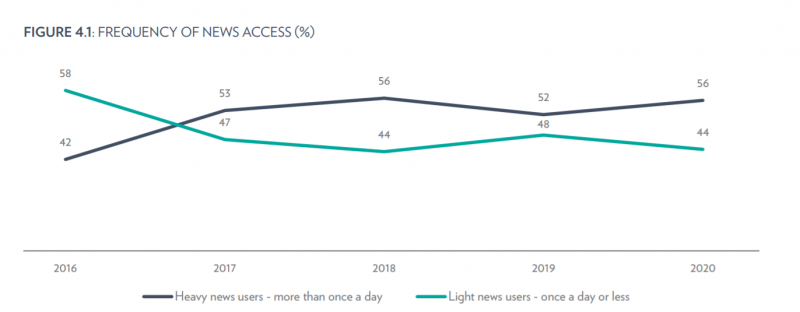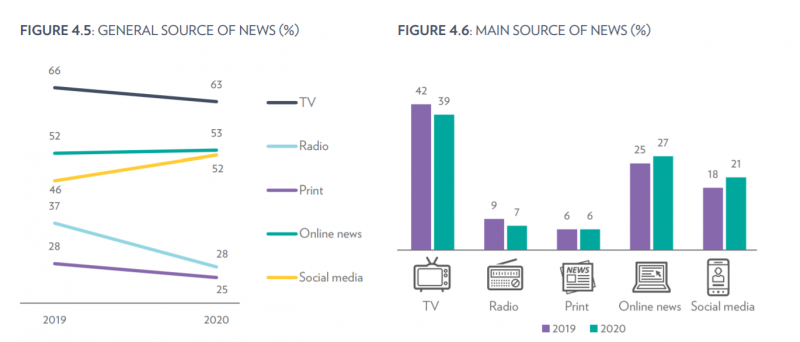Digital News Report shows Australian consumers want independence and impartiality in news and they’re willing to pay for it
54% of news consumers want impartial news and 62% consider independent journalism very or extremely important, according to the annual Digital News Report (DNR) from the University of Canberra.
Through what has been a traumatic year for Australians, trust in news has fluctuated, plummeting to just 38% during the bushfire crisis, but rising to 53% in the peak of the COVID-19 pandemic, and 61% for local reporting on the virus.
Right-wing consumers are more likely to turn to news that doesn’t have a particular view (63%) than news that supports their world view (21%) or news that challenges their view (9%). Left-wing consumers were slightly more interested in news that shared their world view (22%) and almost double as likely to read information that challenged their view (15%). 56% of left-wing news consumers wanted coverage that didn’t have a particular view.
While only 14% of Australians pay for news currently, the number of those who have ongoing subscriptions is steadily on the rise. Younger people, especially Gen Y, are more likely to pay for news online (20%), particularly if they value independent journalism. Paywalls do not concern most Australians, but 25% of consumers are worried about missing out on the stories behind them.
For the first time, the DNR also reviewed news consumers’ thoughts on climate change. Australia had the highest proportion of climate deniers across the 40 countries which take part in the survey, with 18% saying they think it isn’t a serious issue. Those who access news via commercial AM radio (i.e. 2GB, 2UE, 3AW) (35%), Sky News (35%) and Fox News (32 %) are less likely to think climate change is serious.
Four out of five Australians think climate change is a serious problem, but 15% don’t pay any attention to news about climate change; this is higher in regional areas (21%).
“In an online news environment, those ideals are being increasingly challenged with rise of opinion and clickbait to grab the attention of audiences,” said Dr Park.
“The public broadcaster has also come under attack in the battle over shrinking media markets. It is reassuring for quality news providers to know the majority of Australians prefer impartial and independent coverage.”
The bushfire crisis and COVID-19 saw Australia jump from 2019’s ranking of lowest in news consumption, rising four percentage points to 56% of consumers accessing news every day. That shot up again to 70% of consumers accessing daily news specifically during the pandemic. Interest in news rose from 2019 to 60% but is still on the decline from five years ago when 64% of Australians considered themselves interested in news.
Although it had dropped from 2019, TV was still the primary source of news (39%), followed by online (27%) and social media (21%). Print stayed at 6% while radio fell to 7% from 9% in 2019.
Gen Y (33%) is more likely to access online news than other generations. Print remains popular among people aged 74 or older (16%); however, this is a decline of three points from last year among this age group (19% in 2019).
TV news became even more important during the pandemic – more than half of the respondents (51%) said TV was their main source of news during lockdown, a 12 point bump from the survey conducted in Jan/Feb. All other sources declined.
During the bushfires, 41% of consumers were using local newspapers and their digital presences as the top source of local news, while almost a quarter were turning to local social media groups for news about their community – suggesting a gap in the reporting at a local level.
The majority of consumers surveyed said they would miss local news if it closed, with 76% saying they’d miss local newspapers and 81% saying they would miss local radio. This figure was higher with people in regional areas and people from low-income backgrounds.
The DNR is part of a long-running international survey coordinated by the Reuters Institute for the Study of Journalism. It delivers comparative data on media usage in 40 countries and across six continents. The News and Media Research Centre at the University of Canberra is the Australian partner institute and author of the report.
In 2020, the survey was conducted by YouGov using an online questionnaire between 17 January and 8 February 2020. The sample is drawn from an online panel of 89,850 Australians.




